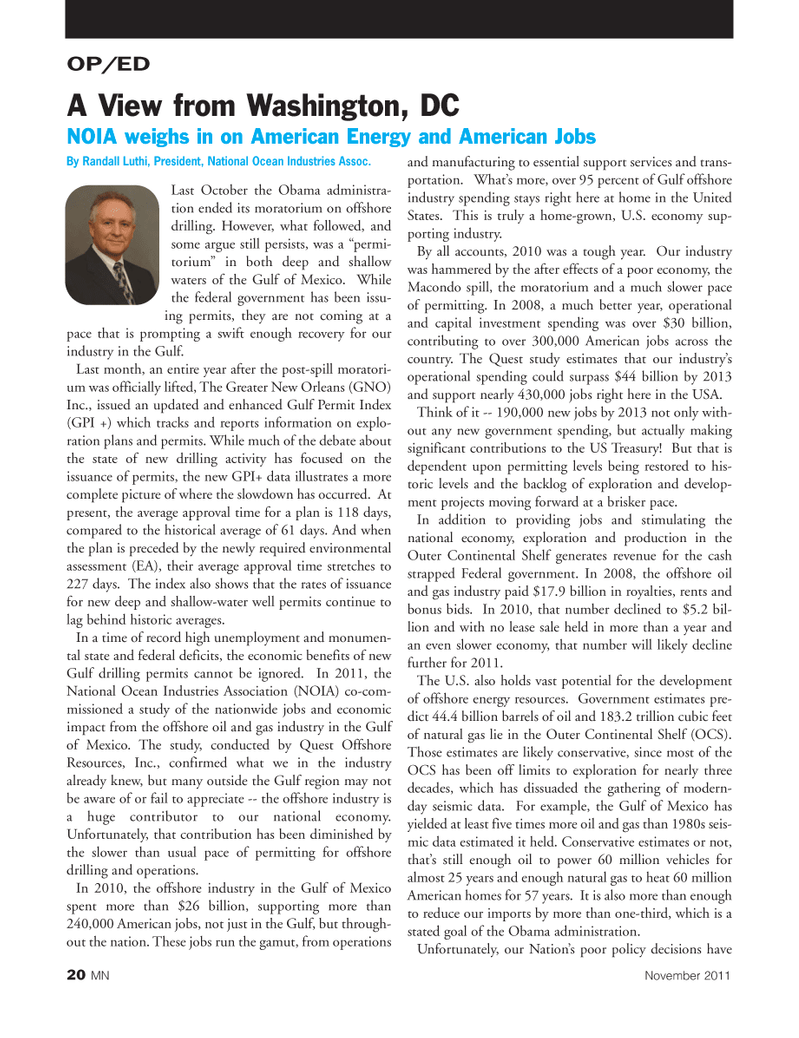
Page 20: of Marine News Magazine (November 2011)
Workboat Annual
Read this page in Pdf, Flash or Html5 edition of November 2011 Marine News Magazine
20MNNovember 2011OP/EDLast October the Obama administra- tion ended its moratorium on offshore drilling. However, what followed, and some argue still persists, was a ?permi- torium? in both deep and shallow waters of the Gulf of Mexico. While the federal government has been issu- ing permits, they are not coming at a pace that is prompting a swift enough recovery for our industry in the Gulf. Last month, an entire year after the post-spill moratori- um was officially lifted, The Greater New Orleans (GNO) Inc., issued an updated and enhanced Gulf Permit Index (GPI +) which tracks and reports information on explo- ration plans and permits. While much of the debate about the state of new drilling activity has focused on the issuance of permits, the new GPI+ data illustrates a more complete picture of where the slowdown has occurred. At present, the average approval time for a plan is 118 days, compared to the historical average of 61 days. And when the plan is preceded by the newly required environmental assessment (EA), their average approval time stretches to 227 days. The index also shows that the rates of issuance for new deep and shallow-water well permits continue to lag behind historic averages. In a time of record high unemployment and monumen- tal state and federal deficits, the economic benefits of new Gulf drilling permits cannot be ignored. In 2011, the National Ocean Industries Association (NOIA) co-com- missioned a study of the nationwide jobs and economicimpact from the offshore oil and gas industry in the Gulf of Mexico. The study, conducted by Quest Offshore Resources, Inc., confirmed what we in the industry already knew, but many outside the Gulf region may not be aware of or fail to appreciate -- the offshore industry is a huge contributor to our national economy. Unfortunately, that contribution has been diminished by the slower than usual pace of permitting for offshore drilling and operations. In 2010, the offshore industry in the Gulf of Mexico spent more than $26 billion, supporting more than 240,000 American jobs, not just in the Gulf, but through- out the nation. These jobs run the gamut, from operations and manufacturing to essential support services and trans- portation. What?s more, over 95 percent of Gulf offshore industry spending stays right here at home in the United States. This is truly a home-grown, U.S. economy sup- porting industry. By all accounts, 2010 was a tough year. Our industry was hammered by the after effects of a poor economy, the Macondo spill, the moratorium and a much slower pace of permitting. In 2008, a much better year, operational and capital investment spending was over $30 billion, contributing to over 300,000 American jobs across the country. The Quest study estimates that our industry?s operational spending could surpass $44 billion by 2013 and support nearly 430,000 jobs right here in the USA. Think of it -- 190,000 new jobs by 2013 not only with- out any new government spending, but actually making significant contributions to the US Treasury! But that is dependent upon permitting levels being restored to his- toric levels and the backlog of exploration and develop- ment projects moving forward at a brisker pace. In addition to providing jobs and stimulating the national economy, exploration and production in the Outer Continental Shelf generates revenue for the cash strapped Federal government. In 2008, the offshore oil and gas industry paid $17.9 billion in royalties, rents and bonus bids. In 2010, that number declined to $5.2 bil- lion and with no lease sale held in more than a year and an even slower economy, that number will likely decline further for 2011. The U.S. also holds vast potential for the development of offshore energy resources. Government estimates pre- dict 44.4 billion barrels of oil and 183.2 trillion cubic feet of natural gas lie in the Outer Continental Shelf (OCS). Those estimates are likely conservative, since most of the OCS has been off limits to exploration for nearly three decades, which has dissuaded the gathering of modern-day seismic data. For example, the Gulf of Mexico has yielded at least five times more oil and gas than 1980s seis- mic data estimated it held. Conservative estimates or not, that?s still enough oil to power 60 million vehicles for almost 25 years and enough natural gas to heat 60 million American homes for 57 years. It is also more than enough to reduce our imports by more than one-third, which is a stated goal of the Obama administration. Unfortunately, our Nation?s poor policy decisions have By Randall Luthi, President, National Ocean Industries Assoc. A View from Washington, DC NOIA weighs in on American Energy and American Jobs MN#11 (18-31):MN 2011 Layouts 10/27/2011 9:08 AM Page 20

 19
19

 21
21
